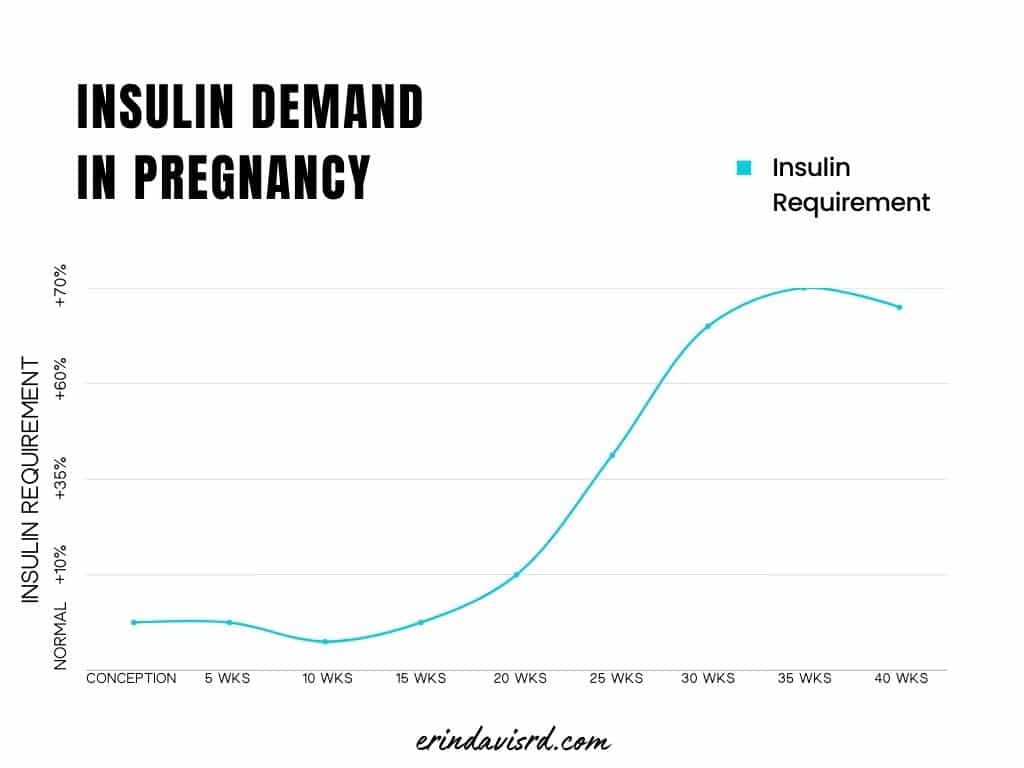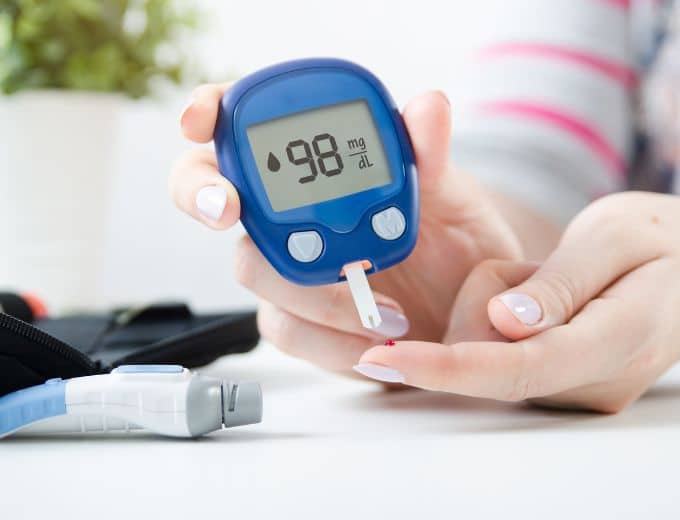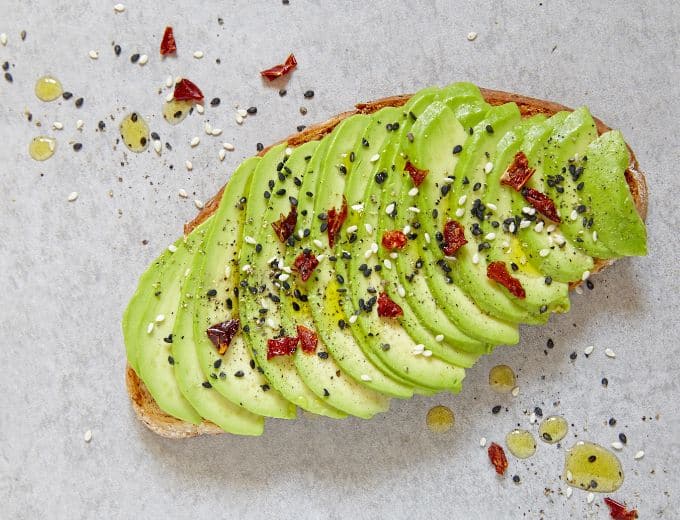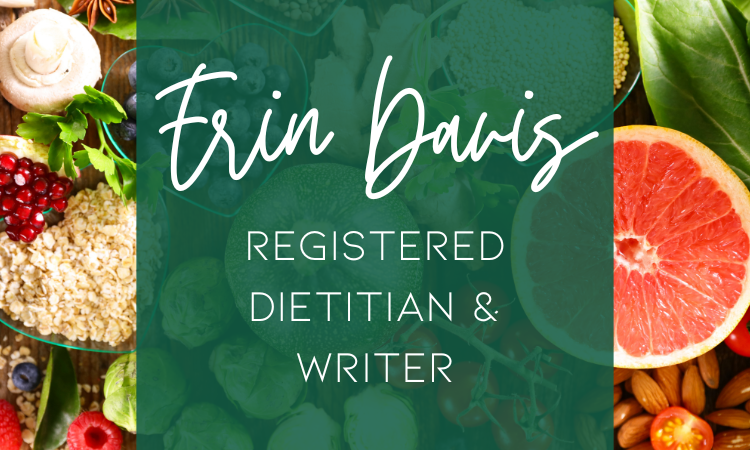One of the trickiest meals to plan with gestational diabetes is breakfast. You may be dealing with high morning blood sugars and wondering what in the world you can eat. In today’s post, I’m providing some breakfast ideas for gestational diabetes that can help you add variety to your meal plan.
It can be difficult to prep healthy breakfasts when you’re not pregnant. You’re in a rush or maybe you’re not hungry so you get in a breakfast rut.
Now add morning sickness or specific diet recommendations that come along with gestational diabetes—usually lower in carb at breakfast time. Contemplating what’s left for you to eat?
Breakfast tends to be the most challenging meal to plan for my clients with gestational diabetes. You can only eat so many scrambled or hard-boiled eggs.

If you’re new here, welcome! I’m Erin, a registered dietitian and certified diabetes care and education specialist. I help people kick dieting to the curb and learn to make peace with food.
If you’re looking for breakfast ideas for gestational diabetes, you’ve come to the right place. In this post, I’m discussing why breakfast is important and why your blood sugars may be high.
There are also breakfast ideas, including non-egg breakfast for gestational diabetes. Let’s jump in!
Please note: As an Amazon Associate, I earn from qualifying purchases.
Blood sugars in pregnancy
Your blood sugar levels may change during pregnancy for a number of reasons.
First, you have an increased insulin demand in the last half of your pregnancy.

Insulin is the hormone that helps to bring blood sugar levels down. You can see from the graph that even if you change nothing about your diet and physical activity, your body needs more insulin to lower blood sugar.
This increased insulin demand, especially in the 3rd trimester, may make it difficult for you to manage your blood sugars.
Plus, the placental hormones are interfering with insulin and its ability to do its job (insulin resistance).
Fasting blood sugar levels during pregnancy may be higher than normal because of this increased demand and insulin resistance.
Target blood sugar for gestational diabetes
Chances are, if you’re reading this post, you’ve been diagnosed with gestational diabetes. You are likely checking your fasting and post-meal blood sugar levels.
The typical recommendation for blood sugar levels during pregnancy is as follows:
- Fasting blood sugar: taken when you wake up
- Target Range: Generally, a fasting blood sugar level <95 mg/dL (5.3 mmol/L) is considered normal.
- 1-hour post-meal: taken one hour after you’ve started your meal
- Target Range: <140 mg/dL
- 2-hour post-meal: taken two hours after the start of your meal
- Target Range: <120 mg/dL
If your blood sugars are over the target, you may be tempted to skip a meal, or wonder what you can eat to lower your blood glucose.
Why is breakfast important?
Breakfast should be a part of your day. Not only is breakfast an opportunity to get in some much-needed nutrients for your baby to grow, but it will help you feel better throughout the day.
Here are some reasons to eat breakfast:
Balanced blood sugar

While you may think skipping breakfast may lower your blood glucose, that is not the case. Rather, eating more frequent meals has been shown to improve glucose levels.
When you eat after you wake up, your blood sugars go up but will come back down.
However, if you skip a meal, your blood sugars will dip low, make you feel terrible, and you will likely crave high-carb foods that will bring your blood sugar back up.
It’s like a roller coaster. Instead of a steady rise and fall of blood sugar, it’s rapid drops and spikes.
Consuming a balanced meal with a mix of complex carbohydrates, protein, and healthy fats helps provide a steady release of glucose into the bloodstream. This helps prevent the rapid rise and subsequent crash in blood sugar that can trigger hunger and cravings.
Prevent overeating

Speaking of hunger and cravings, eating breakfast curbs those intense carbohydrate cravings that happen when your blood sugar dips too low.
If you skip breakfast or eat a meal lacking in nutrients, you may be more likely to experience intense hunger later, leading to overeating and poor food choices.
Protein and fiber-rich foods, commonly found in a balanced breakfast, contribute to a feeling of fullness and satiety.
So, foods like eggs, yogurt, whole grains, and fruits can help you stay satisfied for a longer period.
Promote mindful eating

Do you ever experience the post-work binge at the pantry door or fridge?
You’re under fueled and when you finally have access to food, all bets are off. This is one of the reasons I don’t like restrictive diets—intuitive eating for diabetes works better!
Having a structured meal in the morning encourages a routine of regular, mindful eating.
This can lead to a more conscious approach to food throughout the day, making it less likely that you’ll succumb to impulsive or emotional eating later on.
Emotional eating makes it difficult to manage blood sugars. I have other mindful eating exercises you can try if you struggle in this area.
Tips for a healthy breakfast
You’ll want to get a wide variety of nutrients throughout your pregnancy to support the proper growth and development of the baby.

Some key nutrients include:
- Folic Acid (Folate):
- Role: Essential for early fetal development, especially in the formation of the neural tube.
- Sources: Leafy green vegetables, citrus fruits, fortified cereals, beans, and lentils.
- Iron:
- Role: Vital for preventing maternal anemia and supporting the increased blood volume during pregnancy. Also important for the baby’s development.
- Sources: Lean meats, poultry, fish, fortified cereals, beans, and spinach.
- Calcium:
- Role: Critical for the development of the baby’s bones and teeth.
- Sources: Dairy products, leafy green vegetables, fortified plant-based milk, and calcium supplements if necessary.
- Protein:
- Role: Important for the development of the baby’s tissues and organs.
- Sources: Lean meats, poultry, fish, eggs, dairy products, beans, lentils, and nuts.
- Omega-3 Fatty Acids:
- Role: Essential for the development of the baby’s brain and eyes.
- Sources: Fatty fish (e.g., salmon, mackerel), walnuts, flaxseeds, chia seeds, and omega-3 supplements if recommended by a healthcare provider.
- Vitamin D:
- Role: Critical for the absorption of calcium and the development of the baby’s bones and teeth.
- Sources: Sun exposure, fatty fish, fortified dairy products, and vitamin D supplements if needed.
- Iodine:
- Role: Essential for the development of the baby’s brain and nervous system.
- Sources: Iodized salt, seafood, dairy products, and iodine supplements if recommended by a healthcare provider.
- Vitamin C:
- Role: Supports the absorption of iron and helps with tissue repair and growth.
- Sources: Citrus fruits, strawberries, bell peppers, tomatoes, and broccoli.
- Vitamin A:
- Role: Important for the development of the baby’s eyes, bones, and skin.
- Sources: Orange and yellow vegetables, spinach, sweet potatoes, and liver (in moderation).
- Zinc:
- Role: Essential for cell division and the formation of DNA.
- Sources: Meat, dairy products, nuts, seeds, and legumes.
Near the end of your pregnancy, as that insulin demand is at its peak, you may need to modify your meals a bit.
While I don’t typically promote “diet” foods, this is a time where some of those specialty items are useful.
For example, low-carb, high-fiber bread and English muffins, or waffle mix. You’ll find affiliate links to some of these products in the list of meal ideas.
I should also mention that it’s not uncommon to need to save certain carbs, like fruit and milk, for later in the day, when your insulin is working better to lower blood sugars.
Eat your protein first

While it may seem silly, the order in which you eat your food impacts your post-meal blood sugar levels.
Research has found that when you eat your protein and fat first and save your carbs for last, your post-meal blood sugars are improved.
This can be a simple strategy to try when you are looking to lower your numbers.
Breakfast ideas for gestational diabetes

The general breakfast formula is protein, high-fiber carbohydrates, and fat. A major go-to is eggs. Eggs are high in protein and low in carbs.
Additionally, eggs are rich in choline, a nutrient that is important for the development of the baby’s brain and spinal cord. Choline is also involved in the formation of cell membranes.
Here are some ways you can eat eggs:
- Egg and Cheese Breakfast Burrito: Wrap eggs, cheese, and veggies in a tortilla.
- Waffle Sandwich: Put eggs, cheese, and bacon between two waffles.
- Breakfast Quesadilla: Fill a tortilla with eggs, cheese, and veggies.
- Egg Muffins: Bake eggs with veggies in muffin tins for a portable option.
- Breakfast Wrap: Scrambled eggs, cheese, and salsa in a tortilla.
- Potato Scramble: Crispy potatoes and eggs with onions and peppers.
- French Toast: Dip bread in an egg mixture and cook until golden brown.
- Breakfast Pizza: Top a whole-grain crust with eggs, cheese, and veggies.
- Egg and Spinach Breakfast Sandwich: English muffin with eggs and spinach.
- Shakshuka: Poached eggs in a spicy tomato and pepper sauce.
- Breakfast Tacos: Fill tortillas with scrambled eggs, cheese, and salsa.
- Egg Salad on Toast: Mix boiled eggs with mayo and seasonings.
- Breakfast Sushi: Roll up scrambled eggs and veggies in a nori sheet.
- Scrambled Eggs:
- Classic: Butter, salt, and pepper.
- Cheesy: Add your favorite cheese while cooking.
- Creamy: Stir in a bit of cream or milk for a softer texture.
- Mediterranean: Mix in diced tomatoes, feta, and oregano.
- Fried Eggs: Please note, undercooked eggs are discouraged for food safety reasons
- Poached Eggs:
- Classic: Poach in simmering water and serve on toast.
- Eggs Benedict: Top poached eggs with ham and hollandaise sauce (store-bought is made with pasteurized eggs and is safe for pregnancy).
- Florentine: Poached eggs on a bed of sautéed spinach.
- Boiled Eggs
- Omelet:
- Western: Bell peppers, onions, ham, and cheese.
- Veggie: Spinach, mushrooms, tomatoes, and feta.
- Denver: Ham, bell peppers, onions, and cheese.
- Egg Sandwiches:
- Classic Breakfast Sandwich: Eggs, bacon/sausage, and cheese on a bun.
- Bagel Sandwich: Eggs, smoked salmon, cream cheese, and capers.
- Avocado Egg Toast: Poached or fried egg on avocado toast.
- Shakshuka: Poached eggs in a spicy tomato and bell pepper sauce.
- Deviled Eggs: Mix yolks with mayo, mustard, and seasonings, then fill egg whites.
- Egg Salad: Chopped hard-boiled eggs mixed with mayo, mustard, and spices.
- Egg Curry: Hard-boiled eggs in a flavorful curry sauce.
- Spanish Tortilla: A thick omelet with potatoes and onions.
- Cloud Eggs: Whipped egg whites baked with the yolk in the center.
- Egg Drop Soup: Whisk eggs into hot broth for a simple and comforting soup.
- Baked Eggs in Avocado: Crack an egg into an avocado half and bake until set.
- Egg and Spinach Breakfast Wrap: Scrambled eggs, sautéed spinach, and cheese in a tortilla.
Breakfast ideas for gestational diabetes that don’t include eggs

If you’ve exhausted the egg list, you’re vegan, or you just don’t like eggs, I’ve got you covered. Besides typical breakfast foods, I’ve included other ideas.
It’s okay to think outside the box and eat any foods at breakfast, even foods that would classically be for lunch or dinner.
- Oatmeal:
- Top with berries, hemp hearts, nuts, and a drizzle of honey or maple syrup for sweetness.
- Savory oatmeal with sautéed vegetables and a sprinkle of cheese.
- Yogurt Parfait:
- Layer Greek yogurt with granola, berries, and a dollop of nut butter.
- Coconut Yogurt with Almonds: Add fresh berries for extra flavor.
- Smoothie:
- Blend together fruits, leafy greens, yogurt, and a splash of your preferred liquid.
- Toast Varieties:
- Avocado toast with cherry tomatoes and a sprinkle of salt.
- Nut butter (peanut, almond, or cashew) on whole-grain toast.
- Peanut Butter Banana Toast: Spread peanut butter on toast and add banana slices.
- Cream cheese and smoked salmon on a bagel.
- Soup:
- Chicken noodle soup for a classic comforting option.
- Vegetable soup with lots of colorful veggies.
- Miso soup with tofu and seaweed.
- Salad:
- Quinoa salad with a variety of veggies and a light vinaigrette.
- Greek salad with olives, feta, tomatoes, and cucumbers.
- Cereal or Granola:
- Rice or Quinoa Bowl:
- Brown rice or quinoa with stir-fried vegetables and your choice of protein.
- Burrito bowl with rice, beans, salsa, avocado, and your preferred protein.
- Quinoa breakfast bowl: Cook quinoa with milk, add berries and nuts.
- Cottage Cheese Bowl:
- Top with pineapple, peaches, or your favorite fruits.
- Protein Smoothie Bowl:
- Make a thick smoothie and top with nuts, seeds, and sliced fruits.
- Stir-Fry:
- Mix your favorite veggies, tofu or meat, and a flavorful sauce.
- Chia Seed Pudding:
- Combine chia seeds with milk or a milk alternative and top with fruits.
- Peanut Butter and Jelly Sandwich: On whole-grain bread for a quick option.
Feel like you need a little more support managing your blood sugars? I can help. I’ve helped many women successfully manage their gestational diabetes and go on to deliver a healthy baby. Book a discovery call or appointment with me to get started.
References:
- Kampmann, Ulla & Knorr, Sine & Fuglsang, Jens & Ovesen, Per. (2019). Determinants of Maternal Insulin Resistance during Pregnancy: An Updated Overview. Journal of Diabetes Research. 2019. 1-9. 10.1155/2019/5320156.
- American Diabetes Association Professional Practice Committee. 15. Management of Diabetes in Pregnancy: Standards of Care in Diabetes-2024. Diabetes Care. 2024;47(Suppl 1):S282-S294. doi:10.2337/dc24-S015
- Yong G, Jing Q, Yao Q, Yang K, Ye X. Changing Meal Sequence Affects Glucose Excursions in Gestational Diabetes Mellitus. J Diabetes Res. 2022;2022:7083106. Published 2022 Jul 21. doi:10.1155/2022/7083106
- Kubota S, Liu Y, Iizuka K, Kuwata H, Seino Y, Yabe D. A Review of Recent Findings on Meal Sequence: An Attractive Dietary Approach to Prevention and Management of Type 2 Diabetes. Nutrients. 2020;12(9):2502. Published 2020 Aug 19. doi:10.3390/nu12092502
- Christifano DN, Chollet-Hinton L, Hoyer D, Schmidt A, Gustafson KM. Intake of eggs, choline, lutein, zeaxanthin, and DHA during pregnancy and their relationship to fetal neurodevelopment. Nutr Neurosci. 2023;26(8):749-755. doi:10.1080/1028415X.2022.2088944
Disclaimer: This information is intended as a self-help tool for your own use, at your own risk. My opinions do not reflect the values, thoughts, or opinions of the Academy of Nutrition and Dietetics or other professional health organizations.
About the author
Erin is a registered dietitian and diabetes educator with almost 20 years of experience. She specializes in weight-inclusive diabetes care and prevention, intuitive eating, fitness, and women’s health. She works as a consultant and writer in the health and wellness space. Erin is passionate about empowering people to manage their own health and to have peace with food.


